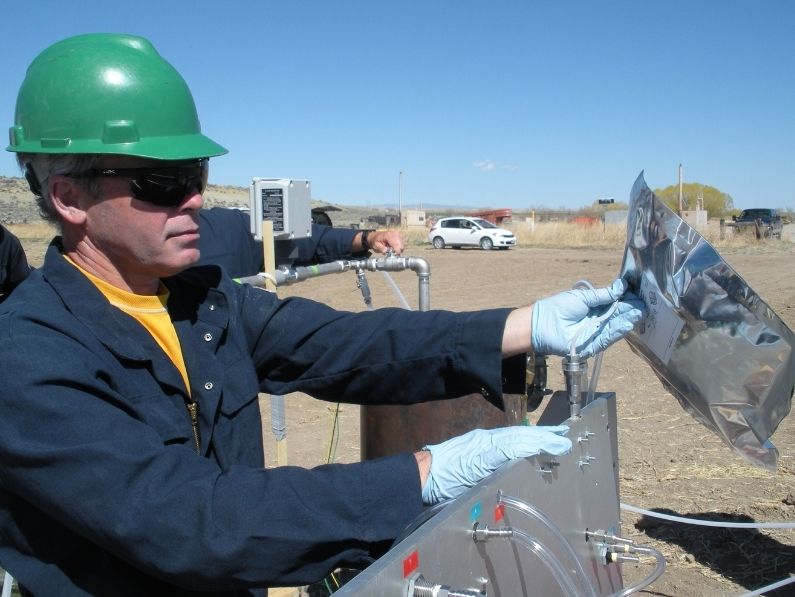Fracking, also known as hydraulic fracturing, involves drilling into the ground to extract oil or natural gas. The practice is controversial because of its potential impacts to public health and the environment. Specifically, it can poison drinking water. After years of research, scientist Dominic DiGiulio made this link. He found that people’s groundwater can become contaminated under certain conditions. The pits that store fracking chemicals are one example. Such was the case in Pavillion, Wyoming, a community of roughly 230 people.
Back in 2008, residents began complaining their water had a foul taste and smell. So the Environmental Protection Agency (EPA) came in to investigate. Led by DiGiulio, the team’s preliminary findings released three years later suggested fracking was to blame.
But officials in Wyoming dismissed the findings as a political move. DiGiulio rejects that claim to this day.
“When I worked with EPA, there was no desire with myself and my coworkers to ban fracking,” he says. “That was never the goal. We were simply conducting an investigation on the impact on groundwater resources and people’s wells. So there was never any kind of goal to have any kind of political objective. Ours was simply a technical objective to better understand the impact of hydraulic fracturing on public health and the environment.”
But politics still found the scientists, and due to political pressure, the EPA backed out of the study. DiGiulio, for his part, knew his work wasn’t done.
“The EPA was still in the process of conducting an investigation,” he says. “And that investigation needed to be expanded, so at the time I felt that really that investigation was not complete.”
DiGuilo retired from EPA in 2014 and went on to lead his own study. It was a massive effort with DiGiulio parsing decades of records.
“I took about 18 months to actually go through the data once more. So it was a very time-intensive process,” he says. “I mean, there was a lot of data there. It was definitely lots of digging and going back to the beginning, back to the 1960s, and actually looking at every single record—all the well completion records, all the records on cement bond locks for well integrity, all the water well records. We basically did a very comprehensive review of the records out there just to get a much better understanding of what the problems were.”
DiGiulio’s research made the connection that he had started to draw back in 2011 with EPA. Only this time, the investigation made his findings clearer. Recently, the Wyoming Department of Environmental Quality released its final ruling from its own research on Pavillion, which was funded in part by Encana. That’s the oil and gas company fracking in Pavillion. It determined fracking was not to blame for residents’ contaminated drinking water. And DiGiulio actually agrees with that assessment. But, he says, really, it’s a question of semantics.
“Hydraulic fracturing started at the Pavillion field back in the 1960s and so the flowback that came from hydraulic fracturing was disposed in pits,” he says. “So it was basically Diesel fuel-based fracking fluids that went into the pits, petroleum based fluids. So hydraulic fracturing, the actual process itself, didn’t impact domestic water wells but flowback from hydraulic fracturing was disposed into unlined pits which then contaminated groundwater.”
The saga in Pavillion, Wyoming, is ongoing. Residents reportedly still can’t drink their water and complain of health problems. DiGiulio says contained within this controversy are lessons for people living in the Mountain West.
“In the Rocky Mountain West, there’s fairly deep groundwater resources,” he says. “So, one of the conclusions that came out of that investigation was that yes, deeper groundwater resources were impacted and these resources are important. Not only in Wyoming but throughout the Rocky Mountain West, there’s fairly deep groundwater resources that need to be protected. And that really wasn’t done at the Pavillion facility. So, in terms of groundwater use for the future with sustained droughts and climate change, it’s definitely a concern.”
DiGiulio says the second takeaway from his investigation is that a lack of state regulations dating back several decades still have demonstrable impacts on people’s lives now.
“The state of Wyoming did not really regulate disposal-produced fluids and produced-water into pits until 1984 and there are literally thousands of production wells that were installed or completed in Wyoming prior to 1984,” he says. “And so if you’re a rancher or a landowner in Wyoming, I think you really need to watch out to see if those pits are on your property.”
And if they are on your property, DiGiulio says you should be paying attention to how close they’re positioned to your domestic well.
This story is part of a series with the Rocky Mountain Community Radio collective about fossil fuel usage in the West. Stay tuned for more stories like this one from other reporters from across the region.






